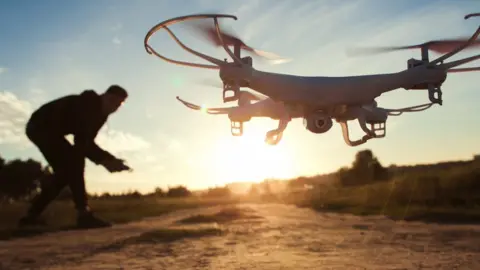UK government's drone collision report criticised
 Getty Images
Getty ImagesManufacturers have criticised a UK government report on the danger of drones colliding with aircraft.
The Department for Transport (DfT) report recommended registration and competency testing, saying helicopters were especially vulnerable to drones.
The Drone Manufacturers Alliance Europe (DMAE) has questioned the evidence gathered in the report and says some of the testing is flawed.
The DfT said it could not comment for security reasons.
Concerns over the safety of drones led to the DfT's report.
In July, a drone flying close to Gatwick Airport led to the closure of the runway and forced five flights to be diverted.
Manufacturers 'working diligently'
According to the UK Airprox Board, there have been 70 near-misses involving drones in 2016, more than double the year before.
DMAE, which accounts for almost 80% of the civil drones operating in the world, said it wanted the department to release the full testing methodology and results of its Mid-Air Collision Study.
"There have been no confirmed collisions anywhere in the world between a modern consumer drone and a traditional aircraft, and drone manufacturers are working diligently on technological solutions to prevent any such collision," DMAE's Daniel Brinkwerth said.
But DMAE maintained that it lacks scientific rigour.
"Many of the shortcomings in this summary report could have been addressed during the research process with more robust participation from all stakeholders. All the major drone manufacturers stand ready to assist with further studies by providing materials for testing as well as research assistance from our experts."
Drone or javelin?
The study, conducted by defence research firm QinetiQ and testing organisation Natural Impacts, compared how helicopter and airliner windscreens would withstand a collision with four classes of drone, weighing from 400g to 4kg.
"Some of the most alarming findings in DfT's summary are based on an object that resembles a javelin more than a drone," Mr Brinkwerth said.
"The study's authors could not find a way to launch a 4kg drone against an aircraft windscreen, so they mounted two motors, a heavy camera and an oversized battery on nylon arms.
"This object could never fly, much less encounter an airliner at high altitude. Researchers need access to the full test results to understand whether this is an acceptable shortcut for scientific research."
The DMAE response document also highlights a US Federal Aviation Administration report which concluded that small drones were far safer to operate than had been previously assumed.
"Its detailed descriptions of testing methodology and exhaustive test results allowed researchers, manufacturers and others to examine the data and use it to improve drone safety," pointed out the DMAE.
